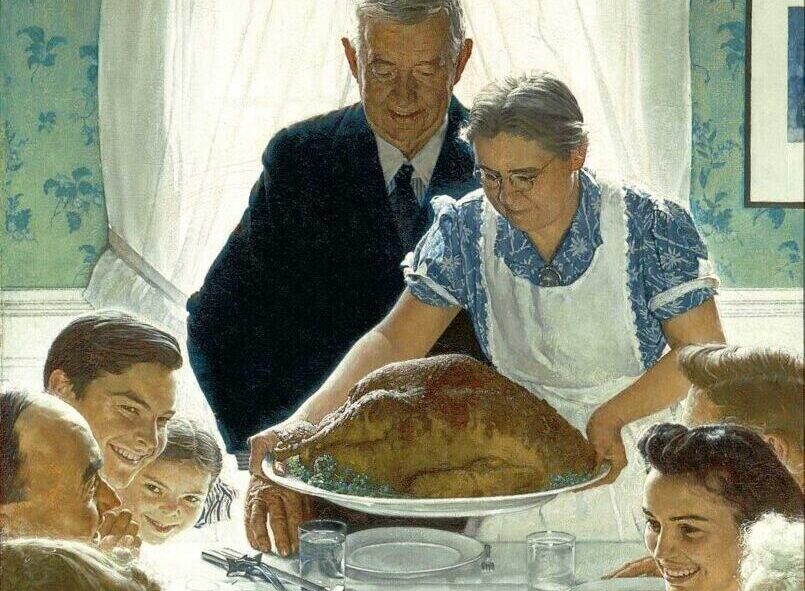The American Ideal
In 1941, the United States had engaged in World War II as with most nations. That year, President Franklin Delano Roosevelt (FDR) gave a speech known as the Four Freedoms Speech. As summarized in the title, FDR listed four fundamental human freedoms America would help secure for a new world. Rockwell derived the illustration we see today from the speech. Titled Freedom from Want, it depicts the third freedom in a four-part series supporting the U.S. war efforts.
These illustrations soon veiled the cover of The Saturday Evening Post, the magazine Rockwell worked for. However, Freedom from Want received backlash overseas, as the excessive lifestyle it featured appeared at odds with how Europe suffered from the onslaught of war. While Rockwell eventually shared this criticism, the work became what some would consider an ideal Thanksgiving and one of the greatest 80 years later. Let’s consider why.
The Composition
Norman Rockwell was meticulous about how his works were staged. After carefully positioning the subjects, he would capture the image with a film camera to ensure the realness of his illustrations. In Freedom from Want, a large family gathered together for dinner, their silhouettes surrounding the table, framing the food and pristine tableware. The table takes up roughly two thirds of the painting, placing the horizon to the upper third. The plates, glasses, food, and people lead our eyes to the center of the illustration, where the focal point is established.
Focal Point
At the center of the painting, a stuffed turkey is laid out ornately on a white milk glass plate held by the matronly grandmother. The grandfather’s deep black suit contrasts with the grandmother and separates her from the bright sunlight entering from the window behind them.
The Colors
Rockwell layered his whites when painting, which sometimes left them peaked and thick, but doing so gave a distinct vibrancy to them. In Freedom from Want, sunlight pours into the room through the window, the warm glow permeating the tablecloth and drapes, the glass and silverware sparkling, and the grandparents surrounded by an almost angelic rim light. Creamy white is complimented by various green and brown tones. The former is a common device artists use to symbolize growth and plenty. We can see this idea clearly in place with literal plants printed on the nourishing green wallpaper and the fresh green vegetables spilling onto the table. The brown hues sit favorably in rounded shapes on the table and in the form of a pot-bellied turkey—this conjures feelings of fullness and savor.
Our Seat at the Table
There is an energy coming from the family members sitting around the table. Their big smiles and the glances they give to one another exude enthusiasm. The painting also gives a sense that we are included in it, which I consider the true magic of this work. In the bottom right corner, a person regards us with a look in his eyes as if we ourselves share his excitement and anticipation. This makes us the final members of this big happy family, ready to sit and share their meal. It turns out that Norman Rockwell paints us in a simple but deliciously comfortable moment of daily living together, united with family.
A Familiar Place
The art community has debated as to whether Norman Rockwell was an artist in the traditional sense or simply a magazine illustrator. But what I find unique to his work is how, by nature, they become easily understood and, more importantly, felt. Moreover, they incorporate a humble and reassuring quality without losing any boldness in composition and color, as if being taken straight from the ordinary lives of the common people, the working class of America’s Midwest. They portray the quotidian: man hard at work, neighbors indulging in leisure, or children curious about the adult world, like in his painting Girl at Mirror. However, people can look at them beyond comfortable renderings of happy lives—and see the ideal of a life they believe in, the one they want. These works of beauty make them feel content in their own lives, as the characters from their illustrated worlds become symbols of the loved ones in theirs—think about a grandmother bringing out a plumped turkey with crisp golden skin on a warm afternoon. Then, there is the best part: until now, we still have a seat at the table.

